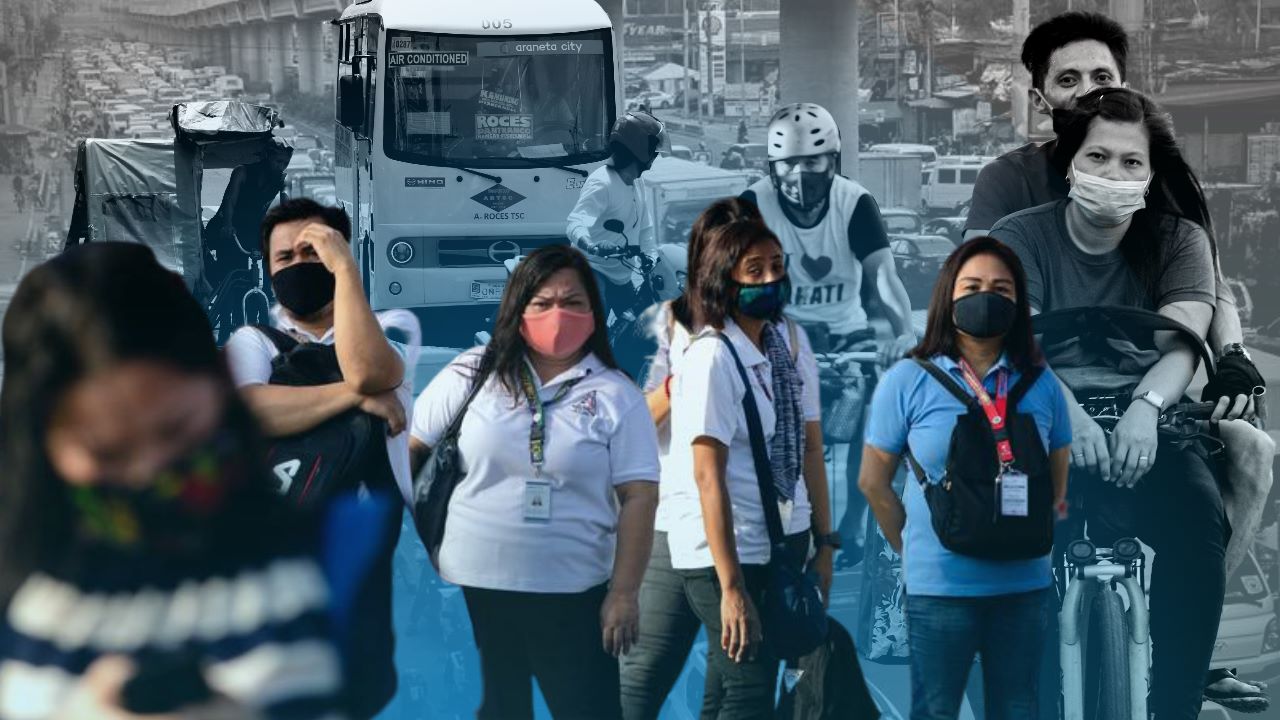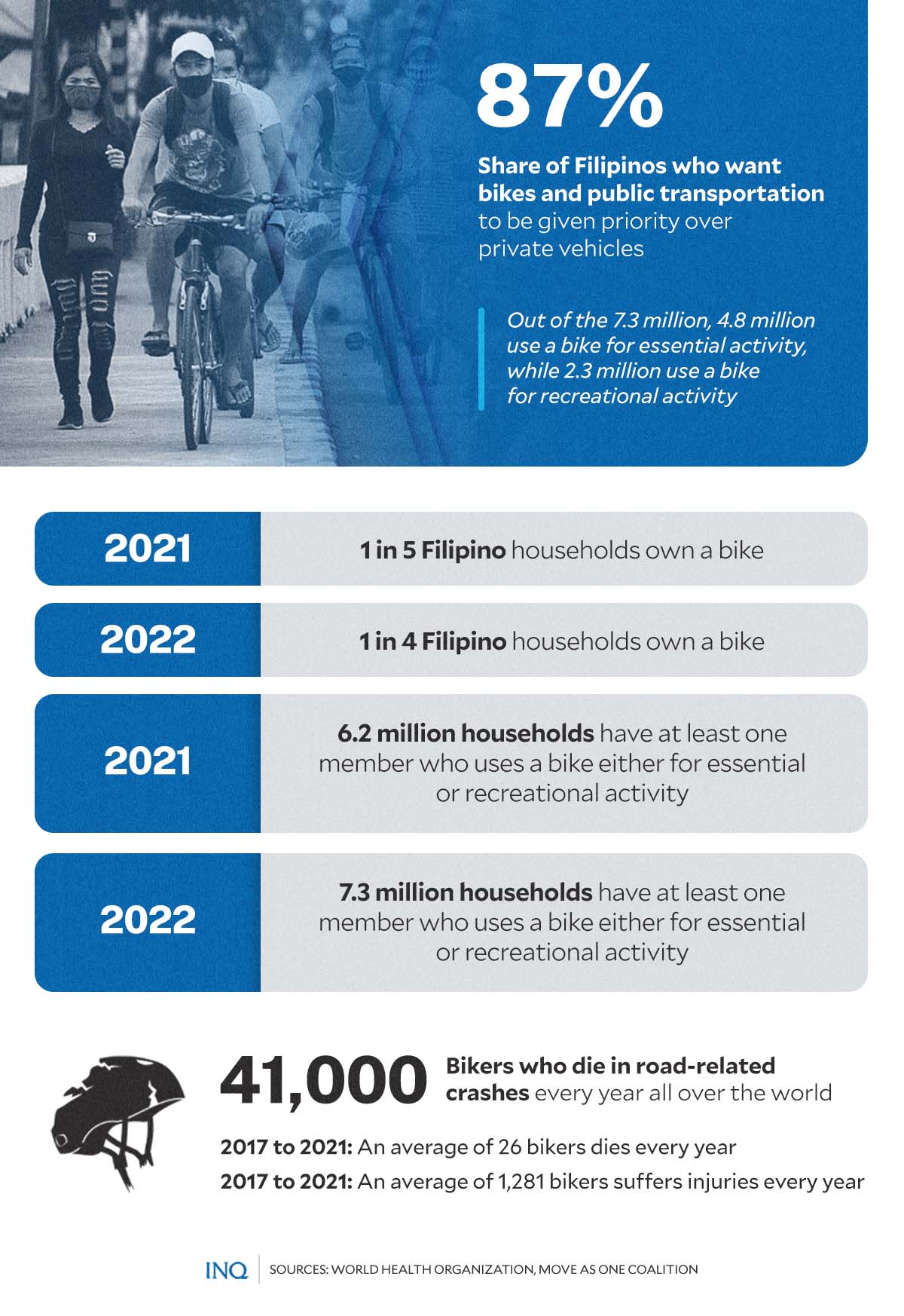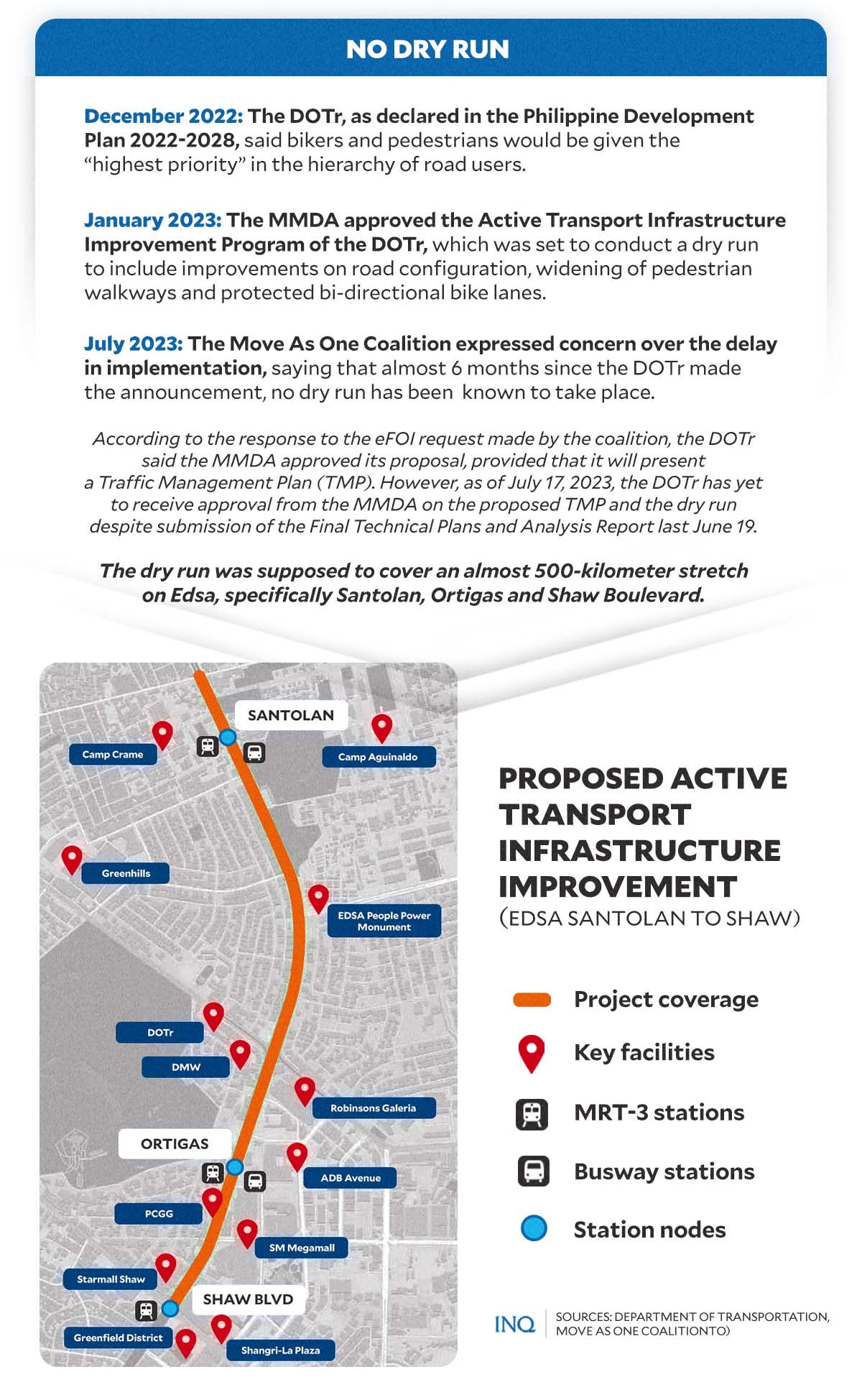Group awaits enforcement of policy giving bikers, public transport road use priority
MANILA, Philippines—In 2021, an overwhelming 87 percent of Filipinos made clear that they want bikes and public transportation to be given priority in road use over private vehicles.
In response, the government declared, through the Philippine Development Plan (PDP) 2023-2028, that “pedestrians and cyclists will be accorded highest priority in the hierarchy of road users.”
RELATED STORY: Cost of mobility: Philippines promises to pave better road networks for bikers
According to 2022 data from the Social Weather Stations (SWS), one in four Filipino households owns a bike, higher than one in five in 2021, at the height of COVID-19 lockdowns.
Households with at least one member who uses a bike for essential or recreational travel also grew to 7.3 million in 2022 from only 6.2 million in 2021.
SWS said out of all the “cycling households,” 4.8 million used a bike in 2022 for essential travel, like going to work, while 2.3 million used it for recreation, like exercise.
Article continues after this advertisementBut bikers need protected lanes, according to the group Move As One Coalition (MAO) which pointed to studies showing how protected bike lanes make it safer to bike and roads safer for everyone.
Article continues after this advertisementREAD: DOTr plan: Pedestrians, bikers get top priority
This was the reason that the group expressed concern over the almost six-month delay in the implementation of the Department of Transportation’s (DOTr) Active Transport Infrastructure Improvement Project (ATIIP).
Better, safer roads
The DOTr had said the Philippines has 564 kilometers of bike lanes, most of which, or 313.12 kilometers, are in Metro Manila, while some are in Metro Cebu and Metro Davao.
The ATIIP, which is part of the partnership between the DOTr and the Department of Public Works and Highways (DPWH), has already been approved by the Metro Manila Development Authority (MMDA) earlier this year.
MMDA’s green light was followed by a statement from the DOTr that it will conduct a dry run of the project over Edsa, specifically Santolan, Ortigas, and Shaw Boulevard.
According to the DOTr in its Traffic Management Plan (TMP), the dry run, which will will include improvements in road configuration, widening of pedestrian walkways and protected bi-directional bike lanes, is essential to:
- Improve the safety and convenience of pedestrians and cyclists along parts of Edsa that are considered as ideal walkways in terms of distance and accessibility to commercial centers.
- Aid in resolving bottlenecks caused by poor road configuration and merging vehicles from Shaw Underpass (northbound), Edsa and Julia Vargas Avenue.
However, six months later, no dry run has been known to take place.
This is “gravely concern[ing],” MAO said. The delay, it said, has already held back the implementation of the ATIIP, which seeks, too, to “encourage private vehicle users to use non-motorized modes of transport, thereby improving traffic flow.”
MMDA inaction?
Puzzled, the coalition sent an eFOI request to the DOTr last month to clarify if the dry run was already conducted—and if yes, what were the findings. There was no definitive reply from the DOTr, though.
Tne group found that earlier this year, the MMDA approved the DOTr proposal for a dry run but on condition that a traffic simulation in the dry run area—Santolan, Ortigas and Shaw Boulevard—is presented first.
The DOTr said between February to June this year, it has tried to address the concerns of the MMDA regarding traffic data, and finalized the TMP for the dry run of the project.
However, as of July 17, “the DOTr has yet to receive an approval from the MMDA” on the proposed TMP and the conduct of the dry run despite submission of requirements—technical plans, analysis report and TMP—to the MMDA last June 19.
According to the TMP, the establishment of active transport infrastructure, which includes inter-city bicycle lanes, walkways, and public transport stops, among others, is in line with these:
- PDP 2023-2028
- 2017 National Transport Policy issued by the National Economic and Development Authority
- Joint Administrative Order on “The Guidelines on Proper Use and Promotion of Active Transportation” of the DOTr, the Department of Health, Department of Interior and Local Government and the DPWH
- Other government issuances since 2020
As MAO stressed, it is puzzled by MMDA’s “lack of urgency,” pointing out that Filipinos “have the right to know MMDA’s reasons so that we can keep the agency accountable for fulfilling the declaration” in the PDP 2023-2028.
INQUIRER.net already reached out to MMDA acting chairman Don Artes, and even its public information office, but both have yet to respond.
‘Protected bike lanes now’
The group appealed to MMDA to immediately implement the dry run of the ATIIP and work with all stakeholders, including pedestrians and cyclists to ensure the project’s success.
Why is there a need for protected bike lanes?
MAO cited a study published in the Journal of Transport & Health which said “bike facilities act as ‘calming’ mechanisms on traffic, slowing cars and reducing fatalities.”
RELATED STORY: Ensure safety of cyclists, transport advocates urge gov’t
According to data from the World Health Organization (WHO), 41,000 cyclists die in road crashes every year worldwide. “Many leave their homes as they would on any normal day—for school, work, worship or meeting friends—never to return,” said WHO in a report.
In the Philippines, MAO said from 2017 to 2021, an average of 26 cyclists died every year, or 130 deaths in four years. In the same period, at least 1,281 cyclists are injured in accidents every year, too, or a total of 6,405.
The coalition said “protected bike lanes may nudge public transport users to shift to using a bicycle, thereby freeing up space on a train, bus or jeepney and reducing queues and waiting times on crowded public transport.”
Last month, the DOTr said “we aim to increase our established bike lanes to 2,400 kilometers by the year 2028.”
This year, the DOTr said it planned to expand protected bike lanes, including pedestrian infrastructure, by 470 kilometers, earmarking P933 million for the expansion program that will cover these regions:
- Ilocos
- Calabarzon
- Metro Manila
- Central Luzon
- Central Visayas
- Western Visayas
- Eastern Visayas
- Bicol Region
- Davao Region


